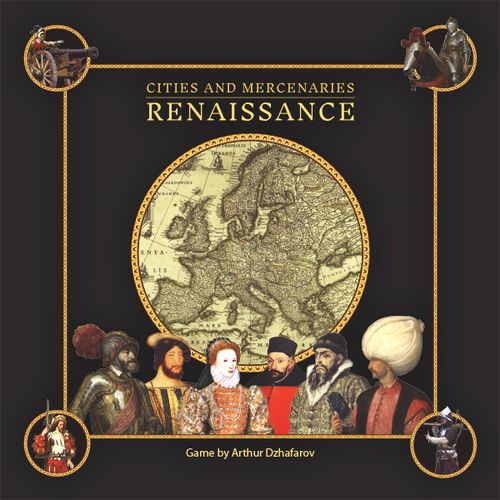Description
In the 15th and 16th centuries, the struggle for control of Europe seemed to have reached its peak. The Great Powers, using mercenaries gathered from all over Europe, have torn her to pieces. The borders of the Great Powers were constantly changing, and cities were passed from hand to hand like hunting trophies...
In this strategic game, players need to build a common Game Area out of City Tiles and establish control over cities to gain more Victory Points.
Key features:
1) In the Core Game uses 42 unique City Tiles. Each City has 4 ways to connect to other Cities. Therefore, in each game, the players create a new Game Area.
2) Instead of the usual resources (wood, stone, iron, etc.), the game uses mercenaries: Infantry, Shooters, Cavalry and Artillery. Each type of mercenary has 3 levels - the higher the level, the higher the ability of the unit. In total, there are 12 Unit Tokens in the game. Tokens have two sides and can be placed secretly. This creates huge opportunities for bluff and tactical combinations.
3) The main way to obtain Unit Tokens is to create Political Ties between cities. The more complex the Political Ties, the more and better the Unit Tokens the player receives. This process is like playing Domino. Additionally, Unit Tokens can be bought or obtained free of charge upon conclusion of Alliances.
4) The gameplay is divided into 5 Phases, which reflect the main aspects of the politico-military life of the Renaissance rulers and are consistently repeated in each Round. All phases are interconnected: the decisions made by the player in each phase have a definite influence on his subsequent actions. The strict sequence of phases allows players to carry out long-term planning.
5) Each phase consists of several special actions available to all players. On a turn, the player cannot perform more than one action in a row. After each action, the turn is passed to the next player. All this speeds up of the gameplay, removes downtime and ensures high interaction between players.
6) The competition of the gameplay depends on the skill of the players and their intentions. Usually errors are not critical if you are playing with players of your level. You can make up your failure to do some things by successfully doing others.
7) The game can be completed in the First Round if at least one player can gain control of 5 or more Cities around their Capital City. Otherwise, the Round becomes the Final when there are fewer cities than the players.
8) Victory Points are calculated only at the end of the game. Victory Points are awarded for different tasks, so there are different ways to achieve Victory.
9) The Core Game (2-4 players) is a well-balanced strategy, with a simple and clear gameplay that can be easily mastered by casual players. However, the results of the game depend on the skills and experience of the player.
10) Expansions increase the number of players to 5-6, and increase the depth and asymmetry of the gameplay.
The game has adjustable gameplay complexity, modular design, high replayability and interaction. The game is especially suitable for players who like mechanics Tile Placement and Area Control.


Comments (0)